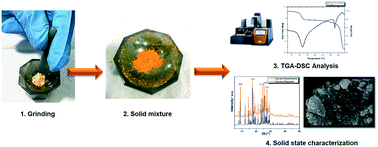Mechanochemical treatment of quercetin and curcumin to obtain eutectic mixtures with high antioxidant activity†
Abstract
Quercetin and curcumin are well-known natural antioxidant molecules used to prevent the malignant effect caused by free radicals on biological systems. This work addressed the creation of eutectic mixtures from quercetin and curcumin molecules through mechanochemical treatment, that is, 75%, 50%, 20%, and 10% mixtures of curcumin and quercetin were obtained by mechanochemical synthesis. Moreover, the grinding time and solvent-assisted variables were tested to obtain the best conditions for creating eutectic mixtures. The obtained products were characterized by differential scanning calorimetry (DSC), thermogravimetric analysis (TGA), ultraviolet-visible (UV-vis) and infrared spectroscopy, powder X-ray diffraction, and scanning electron microscopy. The antioxidant capacities of quercetin, curcumin, and eutectic mixtures were evaluated using the 1,1-diphenyl-2-pycril-hydrazil (DPPH) radical inhibition method (RFS 50). A superior antioxidant capacity was observed of the mixtures (3.143 mg L−1) compared with the pure components (quercetin = 3.444 mg L−1 and curcumin = 9.141 mg L−1). These results indicate that eutectic mixtures are an excellent option to increase and enhance the biological activity of natural antioxidant products or medicines.

- This article is part of the themed collection: Supramolecular & Polymorphism


 Please wait while we load your content...
Please wait while we load your content...